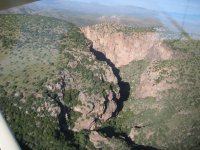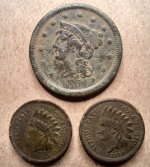sdcfia
Silver Member
- Sep 28, 2014
- 3,654
- 8,871
- Primary Interest:
- Other
sdcfia,
I must disagree. Of all canyons that produced a significant amount of gold, this canyon is the closest to the Arizona border. The mining belt drifts in a north-east path, leaving this area the closest.
As far as the canyon being "Sno-ta-hay", it wasn't. Remember, the men never made it to "Sno-ta-hay". The guide pointed out two peaks a days ride away to the north-east and said that is the canyon he is taking them to. However, we will stay here tonight. However, since the men found gold in this canyon, they never made it to "Sno-ta-hay".
The guide told them that the nuggets at "Sno-ta-hay" were the size of hens eggs. My friend and the company he worked for, found nuggets the size of pocket watches in the "Sno-ta-hay" canyon.
Another little bit of history:
As we know, Jacob Snively left the canyon early, with his gold, because he was afraid of the apaches. Smart guy. He went back towards Tucson and sold his gold. Then he ventured down to where the Gila River meets the Colorado and started a gold rush there. Was actually made mayor for a little over a year, then talked two other men into following him back to New Mexico.
When they arrived at "Sno-ta-hay" they discovered the placer gold and went down to La Mesa to strike their claims. This started the gold rush at Pinos Altos. How did Snively know where "Sno-ta-hay" was? The guide showed them several years earlier.
Everything fits except the dates that all of the books say it happened in. It was not the late 60's, but the late 50's. Snively started the gold rush in Arizona in 58, traveled back to New Mexico and struck his claim for Snively Gold Works in 62.
As you know rooster, there are many versions of the LAD tale - often conflicting in many ways, including those allegedly from Adams himself, who may or may not have even been there. From your posts, it seems like you might be describing Apache Box, below Pine Cienega, as the site (photo below). Or, maybe you're referring to another place. If you post the coordinates, we can look into it, but otherwise it's just another claim that has to be taken at face value. Many folks claim to have located the canyon, but none of those places, including Apache Box, have any indications of significant free gold ever having been present.
I have no response to your pal's supposed results in the 80s - it's just another story. I do accept what you say about your own recoveries, but recreational placer guys, on good days, frequently bring home small amounts of placer. I live in Pinos Altos and I can walk over to my neighbor's place and pan fine gold out of the creek that runs through his property, but it's too much work to make it pay. There are lots of places like that.

Apache Box
Amazon Forum Fav 👍
Last edited:







